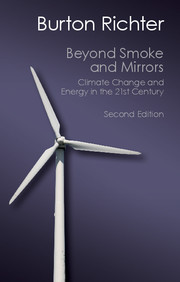Book contents
- Frontmatter
- Contents
- Preface to the Second Edition
- List of Units
- List of Conversion Factors
- List of Abbreviations
- 1 Introduction
- Part I Climate
- Part II Energy
- 6 Taking up Arms Against this Sea of Troubles
- 7 How Fast to Move: A Physicist’s Look at the Economists
- 8 Energy, Emissions, and Action
- 9 Fossil Fuels – How Much Is There?
- 10 Electricity, Emissions, and Pricing Carbon
- 11 Efficiency: the First Priority
- 12 Nuclear Energy
- 13 Renewables
- 14 Biofuels: Is There Anything There?
- 15 An Energy Summary
- Part III Policy
- References
- Index
13 - Renewables
Published online by Cambridge University Press: 05 November 2014
- Frontmatter
- Contents
- Preface to the Second Edition
- List of Units
- List of Conversion Factors
- List of Abbreviations
- 1 Introduction
- Part I Climate
- Part II Energy
- 6 Taking up Arms Against this Sea of Troubles
- 7 How Fast to Move: A Physicist’s Look at the Economists
- 8 Energy, Emissions, and Action
- 9 Fossil Fuels – How Much Is There?
- 10 Electricity, Emissions, and Pricing Carbon
- 11 Efficiency: the First Priority
- 12 Nuclear Energy
- 13 Renewables
- 14 Biofuels: Is There Anything There?
- 15 An Energy Summary
- Part III Policy
- References
- Index
Summary
Introduction
Discussion of renewable sources of energy is where you will find the largest collection of half-truths and exaggerations. The Renewables covered in this chapter include wind-, solar-, geothermal-, hydro-, ocean-, and biomass-energy systems (biofuels are treated in the next chapter). According to the IEA’s Key World Energy Statistics for 2013 [15], the renewables make up about 13% of world total primary energy supply (TPES) as they did in 2008, but the only two that make a significant contribution to emission-free energy today are large-scale hydroelectric dams and biomass. Large hydropower systems supply 18% of world electricity and 4% of TPES, but are often not included in the definition of renewables for reasons that involve value judgments that have nothing to do with greenhouse gases and global warming. Biomass, which contributes 7% of TPES, is the use of waste plant and forest materials for energy and is the fuel that the poorest people have available for heat and cooking as well as supplemental fuel for energy in more developed nations; I will come back to it briefly in the chapter on biofuels.
When large hydro and biomass are excluded, only a tiny part of TPES comes from wind, solar electrical, geothermal, ocean, and biofuel systems: about 2% in the Unites States, but less than 1% worldwide. Of these, wind is the largest, supplying about 3% of US electricity in 2013, but has problems because it is intermittent and the best sites are often not where the largest demand is. Solar energy’s problem is that the Sun does not shine all the time and no good method of storing electricity exists. A new source of geothermal energy from deep, hot, dry rock is being developed which, if successful, will allow a big expansion of geothermal power, but it was tried in the 1970s and failed – the jury is still out on this one. The oceans are a harsh environment and ocean systems have not worked so far. New technology is being tried.
Information
- Type
- Chapter
- Information
- Beyond Smoke and MirrorsClimate Change and Energy in the 21st Century, pp. 238 - 271Publisher: Cambridge University PressPrint publication year: 2014
